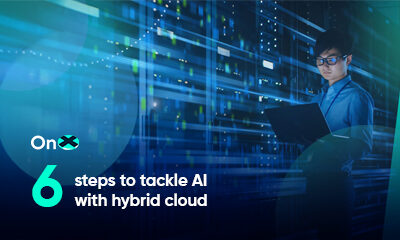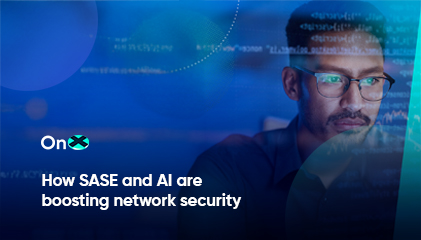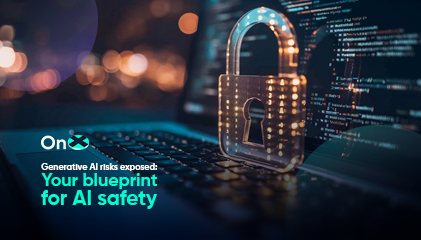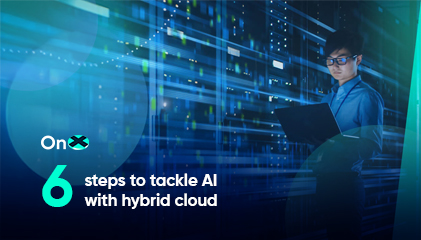
This Tech Talk focuses on embedded AI and its ability to drive greater workplace efficacy. Host Lance Hart and speakers Justin Rice and Jon Lloyd discuss how embedded AI can benefit employees during sales calls, follow-ups, meetings, and content creation. They also discuss latent risks and potential issues like data compliance, excessive staff supervision, and implicit bias.
Embedded AI: A growing trend in today’s digital work environment
In the modern workplace, day-to-day business is commonly conducted via digital platforms and tools and, of course, the Cloud. In remote, hybrid, or on-site workforces, employees depend on digital solutions to collaborate and oversee operations and supply chains. Embedded AI is a clear evolution of this digitized work environment. Businesses increasingly view embedded AI as a means of enhancing staff experiences and customer service.
Jon explains that embedded AI can make employees more efficient and cites salespeople as an example. After a sales call, they need to summarize the call, create an actionable follow-up plan, identify further actions in that particular sales process, and work with colleagues to distribute the workload. Embedded AI can streamline the entire process by providing a call transcription and auto-generating a synopsis of the call and follow-up annotations.
Making meetings more impactful
In-person meetings can also benefit from the transcription functionalities of embedded AI and the additional capability of sentiment analysis. The technology is also equipped to highlight key topics discussed by participants in the meeting group. Additionally, it can detect names referenced during the meeting and identify tasks and the employees to whom they were assigned. Embedded AI makes it simple for staff to get caught up if they didn’t attend the meeting or want to review a summary.
Transcription is also evolving to include enterprise research, a vital example of AI’s practical business applications. As the name implies, enterprise research will allow employees to search all the organization’s cached meeting records for a specific word or phrase, with results that go back a few months or possibly several years.
Data policies
Justin pointed out that data compliance will be imperative for organizations when assessing their level of AI readiness. For embedded AI and its accompanying transcription functionality to work, the user persona must have access to an enormous amount of enterprise information. However, exposing this information poses significant risks for the business.
Data governance must apply to AI, both externally and internally. Data governance should focus on potential risks and security issues that originate from outside the enterprise’s networks and systems and the cybersecurity tools like firewalls that can mitigate them. From an internal perspective, data governance must apply to company assets such as an intranet, particularly if it has access to a private generative pre-trained transformer (GPT).
According to Jon, embedded AI is expected to evolve to include the intranet or SharePoint sites. Both are easily searchable—it’s just a matter of maintaining internal data governance.
The relationship between embedded AI and employment
Jon noted that—contrary to popular belief—the intent of AI (and subsequently embedded AI) is to make humans more productive at work, not to put them out of work. For example, Google plans to use AI to automate 30,000 manual functions, allowing employees to focus on other tasks that more directly contribute to core business functions.
Moreover, new jobs are expected to result from embedded AI. AI can’t function without human involvement. Data must be entered for AI to function effectively, and the output needs to be monitored for quality assurance. Humans will be required to evaluate AI’s data processing functions, create data lakes, and authenticate the results it generates.
Having said that, AI will alter job duties. Tasks will be performed more quickly, precisely, and inexpensively than they are by human counterparts. Staff specializing in AI will carefully activate and manage related processes, so they deliver on organizational goals.
Learn more: AI technology amplifies IT efficiency and customer experience
Embedded AI and its role on various platforms
As Justin explained, AI serves a dual purpose in the current digitized workplace. It can enhance efficacy and experiences on the front end and improve the back end, too.
He cited a Microsoft Teams call as a case in point. Embedded AI is featured in the code used for both video calls and active voice calls in order to improve call quality as the call is occurring, with telemetry data also revising streams as they happen.
Callers won’t be aware of this while calls are taking place, but they will notice improvements in their customer service experience.
On the back end, embedded AI can reduce noise. A number of platforms have both noise reduction and noise elimination capabilities, improving meeting quality by negating the sounds of noisy children, street traffic, and yelping dogs.
Learn more: Transforming the digital workplace with AI
The perils that come with AI
Excessive supervision
Embedded AI features a variety of management tools, like demeanor analysis and employee score cards, designed to gauge staff productivity. However, the danger is that these tools can lead to managers placing too high a priority on the data generated by these tools rather than actively monitoring staff performance. As a result, micromanagement can inform the assessments they make regarding the workforce and workflow.
Unintentional prejudice
Another danger of AI is that it could potentially misconstrue data, resulting in implicit discrimination. Take, for instance, AI resume scoring. On one occasion, AI was instructed to flag participation in team athletics as a strong match. AI was further taught to give involvement with golf and lacrosse top status. The problem is that those most predominantly associated with golf and lacrosse tend to be affluent Caucasian men. Consequently, this type of unintentional prejudice is causing businesses to move away from employing AI when analyzing resumes.
Jon added that because humans train AI, it will mirror exactly what it was trained to do. There’s no sense of nuance. So, AI requires constant reskilling.
There’s a phrase in the IT world: garbage in, garbage out, or GIGO. In other words, the data output is only as good—or bad—as the data input.
Preparing for embedded AI
Like everything, embedded AI comes with pros and cons. But CIOs should also give thought to the current state of their infrastructure and if it’s ready for embedded AI.
Once in place, the impact of AI tools can seem ubiquitous. So, Jon advises businesses to address the topic with colleagues, management, and staff. Successfully integrating embedded AI comes down to appreciating its ultimate impact and gathering input from employees in advance of the integration.
Chart your path to embedded AI with OnX’s comprehensive AI-readiness evaluation.
















